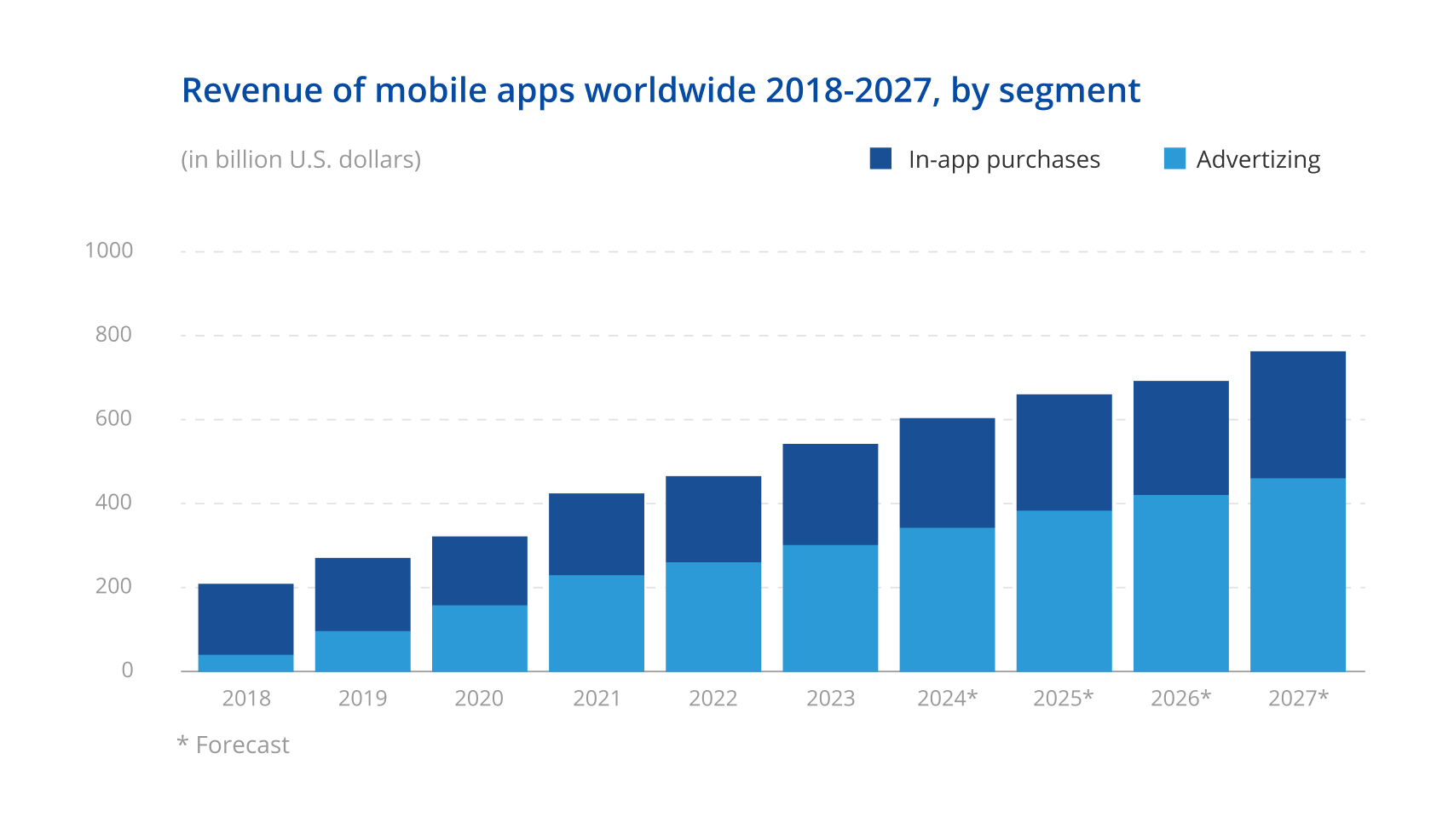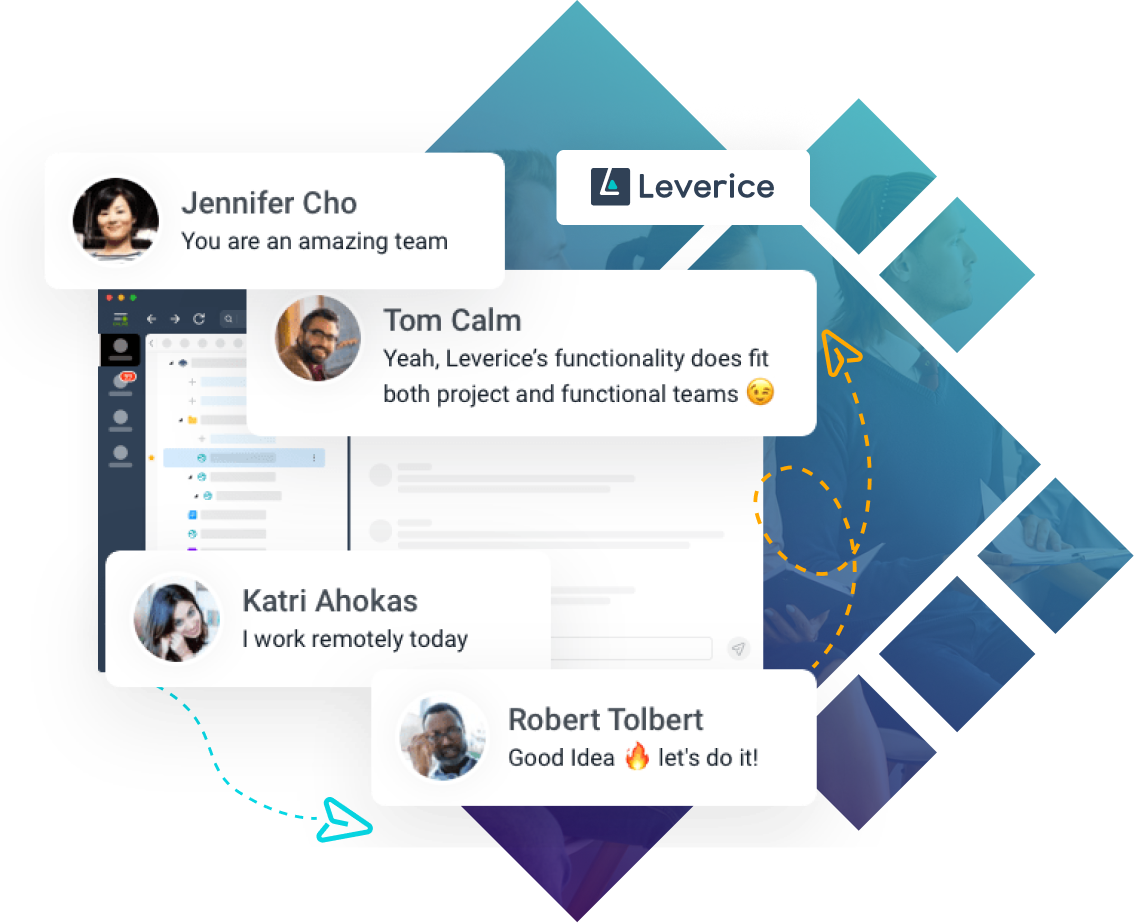Global mobile phone usage statistics show a predominance of just two mobile operating systems. To date, Android maintains the leading position with 70.8% of users and iOS goes second with 28.8% of worldwide mobile users. What’s more, the market of mobile apps is thriving, as more than 90% of time spent on mobile is by engaging with mobile apps. This backs up forecasts of an increase in mobile app revenue up to $935 billion in 2023.

Source: statista.com
With the number of competitors growing exponentially, mobile app developers are faced with the dilemma – what approach to choose:
- To spend less time on development;
- To make robust, scalable, and future-proof apps;
- To allow for easy, low-cost maintenance;
- To leverage OS unique features to the fullest.
This way, the market naturally drives developers to choose between running cross-platform vs native mobile app development. That’s the heart of the issue we’re going to examine in this article.

“Need help implementing your mobile app idea? Talk to us!”
The background of competition in a nutshell
Upon the first introduction of smartphones, software engineers were limited only to a platform-based (native) approach. This means they could build an app for a specific platform only.
If a company wanted to launch an app on different operating systems, the only choice was to build several separate applications. However, today the choice is wider because you can select between cross-platform mobile app development vs native app engineering. This way the apps will work on different platforms using a unified common code database.
Below, we will expand on what lies behind the terms native and cross-platform app development, as well as study the pros and cons of each approach and their subtleties.
Native mobile application: What is it?
Native applications are developed for a specific software platform and written in languages unique to this OS. These include most of the default apps: phone book, file manager, calendar, calculator, and other standard applications, as well as the majority of the most popular apps, mobile video games, and other programs using graphics chips.
Tech specifics of native mobile apps
These apps are built to run on the target platform, with support for all native technologies and hardware capabilities of a particular platform. Both iOS and Android have their own SDK (software development kits) and IDE (integrated development environments). A developer will need to use Android Studio IDE to build an app for Android, while iOS will require Xcode or Appcode.
What’s more, the app technology stack is tied to a specific programming language. For instance, native languages for Android are Java and Kotlin, while for iOS these are Swift and Objective-C. Each platform needs its own development team to make the application work correctly and reproduce the logic and navigation of the operating system.
Pros of native mobile apps
Taking up the native approach to mobile app development brings a bunch of benefits, among them:
High performance
Since the technologies used for platform-dependent applications are directly related to this platform, native code has direct access to all functions of the operating system.
In turn, a simpler interaction with a device’s default features increases the overall performance of the application, in particular when viewing graphical or multimedia content. As a result, building high-load applications with native code can reduce response time and minimize crash chances.
Easy integration with OS capabilities
Native applications are designed and developed to solve specific problems on a specific platform. This leads to a better match of application functionality to the hardware capabilities of devices, including Bluetooth, NFC, camera, GPS, and more. This is necessary when the application should use data such as physical and geographic location, etc.
Enhanced user interface
Since native applications integrate directly with the mobile operating system, leveraging all the available capabilities, users can move around the familiar interface without much hassle. This results in a positive user experience (UX), greater user engagement, and a higher number of return users.
For one thing, we observe a huge number of different smartphone screen resolutions. This highlights the significance of having an application optimized under such a screen to make it comfortable for the user to navigate the application.
Better positioning in app stores
The quality of user experience is an important ranking indicator in app stores. If the application has a high rating of user experience, the system will rank it higher, leading to more recommendations for different audiences and increased revenue from the application, respectively.
There is also a suggestion that the ranking mechanisms in app stores are set up to better position applications native to the platform due to the presupposed higher performance and ease of use.
Cons of native mobile apps
There aren’t many drawbacks of native applications, although for some they can be key factors in choosing the development approach.
High finance and time costs
Without a doubt, creating separate applications for each OS can significantly extend the development process. The same code can’t be deployed on different platforms, and programmers will need more time to convert and rewrite code, which increases development costs and time.
If a company wants to have separate applications for each platform, it will probably have to hire additional software engineers. For example, one developer will focus on iOS applications, and the other – on Android-based ones, which further increases costs.
Incompatibility with other operating systems
Software engineers use a specific language environment for native solutions, making such an application incompatible with other platforms. Let’s say, if your app was written on Swift for iOS, it won’t function on Android because this platform has Kotlin or Java as native languages. This may eventually limit the scope and availability of your product or service.
Limited opportunities for scaling up
If you are focused on a market where a particular OS (operating system) predominates significantly, this disadvantage may not concern you. But if you build a native app for one platform, it can threaten to lose profits. After all, the application will simply not work on other platforms and users will not be able to test your development and start bringing profits.
Cross-platform mobile application: What is it?
Cross-platform applications are developed and then run simultaneously on both Android and iOS. The essence of the approach is in translating the source code into native, i.e., understandable to a specific mobile device. As a result, the program can be integrated with the device’s OS.
For example, cross-platform applications were developed by eBay, Google Ads, and AliExpress. The developers wrote a single code, tested and then launched applications on Google Play and App Store.
Tech Specifics of cross-platform mobile apps
Cross-platform developers write one code for both iOS and Android with the help of cross-platform frameworks. The two most popular frameworks are React Native and Flutter. In such applications, JavaScript is used for functionality, and HTML, or CSS for design.
In addition to a common code base, cross-platform applications have a common interface. This means designers don’t have to stick to two different guidelines (Google Material Design System and the Apple Human Interface Guidelines) and the entire interface will look similar on both OS.
Pros of cross-platform mobile apps
App development for multiple operating systems is gaining popularity and offers several tangible benefits. Among them:
Reduced time and finance expenses
Developers do not need to spend much time learning different frameworks and programming languages, as cross-platform solutions require a single tech stack and codebase. This frees the companies of the need to employ two separate teams to work on each platform’s interface and hardware.
Streamlined maintenance and support
Additionally, the costs for application support and maintenance are minimized. You can update your app quickly as there is no need to make changes separately. The absence of complex platform-based functionality allows you to make prompt adjustments for all the end-users at once.
Wider audience
Games and programs running on different platforms are in greater demand by users. Most of them are willing to pay for the use of such products. This allows you to reach a wider audience and create a strong brand identity. In addition, it guarantees developers a decent profit, part of which can be invested in further development.
Consistent user interface
You can build almost identical designs for any device thanks to the availability of universal tools. This design is highly appreciated by users. Developing an app with a single codebase, ensures the user interface and features are consistent across all platforms.
Cons of cross-platform mobile apps
Hands-on experience shows that despite the benefits it offers, cross-platform development has some drawbacks as well:
No intuitive interface
Users get so used to the interface and functionality of their gadgets that they expect maximum responsiveness from the applications installed. They want to make sure each button is in the right place, the page scrolls at the best speed, and any action gets an immediate response from the system. However, cross-platform applications have a single interface and don’t take much into account the specific features of a particular OS.
Competition of frameworks
In the market of cross-platform solutions, competition is getting more intense every day. While React Native and Xamarin used to be the most popular frameworks, Flutter has now come to the fore. As a result, projects implemented in earlier frameworks could have poorer code support, let’s say, in terms of speed.
Native engineering will not face such a problem. The introduction of new tools is taking place gradually, and knowledge of several programming languages, which is mandatory for a narrow specialist, will allow them to quickly deal with all innovations.
Lower performance ability
Application functionality on different OS can be similar, but complex components that require more computing will load and run more slowly. This can be a setback for some businesses that want their apps to be super potent, fast, and high-performing.
Average flexibility
Compared to native, cross-platform apps don’t tolerate changes in source code. This is due to the universal development tools that prevent deep integration with the hardware part of devices.

Which is Better for Your Business?
Before you answer this question, it is crucial to analyze your business. Consumer segments, the value of time and money resources, the desired depth of app integration with user devices, and well-defined long-term goals – all this is the minimum your choice will depend on.
What’s your target audience?
If you know that the ratio of iOS and Android users among your customers is close to a 50-50 ratio, you can opt for cross-platform development to get the product on both platforms at once. If there is an imbalance of the target audience towards any one platform, it’s better to select the native approach.
How much time for development do you have?
No doubt, a cross-platform product seems a more profitable solution in terms of time, money, and human resources. But be sure to remember that the subtleties of design and functionality can affect the timing of adaptation to the platform. This can eventually take almost as much time as building two native applications because developers will have to write additional parts of the code for problematic areas.
What is your app functionality?
We have already mentioned that native applications can load heavy graphics quickly and without losing quality. Modern cross-platform solutions also allow for achieving high performance regardless of functionality, but the difference can still be seen on weak devices.
Learn how businesses benefit from mindful choice of app development strategy
To Draw the Line
Both approaches have the potential to drive your business growth. All you need is to consider all the specifics of your business, project, and app users before selecting one.
Aim for cross-platform development if:
- You need a robust high-load system;
- You need to build MVP quickly;
- Your resources are limited.
There are also cases when native development will turn out more profitable. It is worth choosing if:
- You want to reduce the time-to-market of the project;
- App’s superior performance is critical;
- You need to build a lightweight app.



















